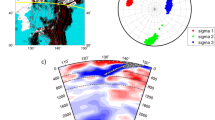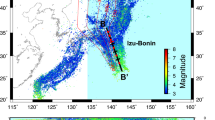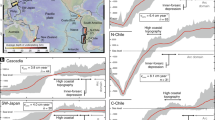Abstract
Subduction zones are fundamental to plate tectonics, yet how they initiate remains enigmatic. Geodynamic models suggest that if horizontal forces dominate, the upper plate experiences compression and uplift followed by extension and subsidence, whereas vertically forced subduction involves only extension. Geologic evidence of past subduction initiation events has been interpreted in terms of these alternatives; however, it is unclear whether they are mutually exclusive or represent different stages of early subduction. Here, we present seismic images of the Puysegur plate boundary south of New Zealand that reveal space–time relations of stress during subduction initiation. Our data show evidence for a stress transition (compression followed by extension) that spread from north to south as the trench nucleated and propagated along the plate boundary. Both the magnitude and duration of compression diminish from north (8 Myr) to south (5 Myr). This indicates that transition to self-sustaining subduction accelerates after nucleation of a downgoing slab increases driving forces and decreases fault strength near the propagating tipline of the nascent trench. Instead of horizontally forced versus vertically forced initiation, we propose a four-dimensional evolution, where horizontal forces initially dominate at the site of nucleation, but with time, vertical forces accelerate, propagate along strike and facilitate the development of self-sustaining subduction.
This is a preview of subscription content, access via your institution
Access options
Access Nature and 54 other Nature Portfolio journals
Get Nature+, our best-value online-access subscription
$29.99 / 30 days
cancel any time
Subscribe to this journal
Receive 12 print issues and online access
$259.00 per year
only $21.58 per issue
Buy this article
- Purchase on Springer Link
- Instant access to full article PDF
Prices may be subject to local taxes which are calculated during checkout





Similar content being viewed by others
Data availability
Uninterpreted and interpreted seismic images shown in this study can be found in the Extended Data (Extended Data Figs. 3–7). Seismic data from the SISIE expedition are available through the Marine Geoscience Data System (https://www.marine-geo.org/tools/entry/MGL1803). Underway geophysical data from MGL1803 are available from the Rolling Deck Repository (https://doi.org/10.7284/907966). Earthquake moment tensors can be accessed online from the gCMT (https://www.globalcmt.org) and GeoNet (https://github.com/GeoNet/data/tree/master/moment-tensor) catalogues. Regional bathymetry data are available through NIWA (https://niwa.co.nz/our-science/oceans/bathymetry) and gravity grids from GNS Science (https://www.gns.cri.nz/Home/Products/Databases/New-Zealand-Region-Gravity-Grids).
Code availability
Maps were generated using the Generic Mapping Tools (GMT) software (https://www.generic-mapping-tools.org).
References
Forsyth, D. & Uyeda, S. On the relative importance of the driving forces of plate motion. Geophys. J. R. Astron. Soc. 43, 163–200 (1975).
Lithgow-Bertelloni, C. R. & Richards, M. Cenozoic plate driving forces. Geophys. Res. Lett. 22, 1317–1320 (1995).
Stadler, G. et al. The dynamics of plate tectonics and mantle flow: from local to global scales. Science 329, 1033–1038 (2010).
Crameri, F., Conrad, C. P., Montési, L. & Lithgow-Bertelloni, C. R. The dynamic life of an oceanic plate. Tectonophysics https://doi.org/10.1016/j.tecto.2018.03.016 (2019).
Stern, R. J. Subduction zones. Rev. Geophys. 40, 1012 (2002).
Crameri, F. et al. A transdisciplinary and community-driven database to unravel subduction zone initiation. Nat. Commun. 3, 3750 (2020).
Gurnis, M., Hall, C. & Lavier, L. Evolving force balance during incipient subduction. Geochem. Geophys. Geosyst. https://doi.org/10.1029/2003GC000681 (2004).
Stern, R. J. & Gerya, T. Subduction initiation in nature and models: a review. Tectonophysics 746, 173–198 (2018).
Stern, R. J. Subduction initiation: spontaneous and induced. Earth Planet. Sci. Lett. 226, 275–292 (2004).
Toth, J. & Gurnis, M. Dynamics of subduction initiation at preexisting fault zones. J. Geophys. Res. 103, 18053–18067 (1998).
Stern, R. J. & Bloomer, S. H. Subduction zone infancy: examples from the Eocene Izu–Bonin–Mariana and Jurassic California arcs. Geol. Soc. Am. Bull. 104, 1621–1636 (1992).
Guilmette, C. et al. Forced subduction initiation recorded in the sole and crust of the Semail ophiolite of Oman. Nat. Geosci. 11, 688–695 (2018).
Arculus, R. J. et al. A record of spontaneous subduction initiation in the Izu–Bonin–Mariana arc. Nat. Geosci. 8, 728–733 (2015).
Hickey-Vargas, R. et al. Origin of depleted basalts during subduction initiation and early development of the Izu–Bonin–Mariana island arc: evidence from IODP expedition 351 site U1438, Amami–Sankaku basin. Geochim. Cosmochim. Acta 229, 85–111 (2018).
Ishizuka, O. et al. The timescales of subduction initiation and subsequent evolution of an oceanic island arc. Earth Planet. Sci. Lett. 306, 229–240 (2011).
Reagan, M. K. et al. Subduction initiation and ophiolite crust: new insights from IODP drilling. Int. Geol. Rev. 59, 1439–1450 (2017).
Shervais, J. W. et al. Magmatic response to subduction initiation: part 1. fore-arc basalts of the Izu–Bonin arc from IODP expedition 352. Geochem. Geophys. Geosyst. 20, 314–338 (2019).
Stern, R. J. J., Reagan, M., Ishizuka, O., Ohara, Y. & Whattam, S. To understand subduction initiation, study forearc crust: to understand forearc crust, study ophiolites. Lithosphere 4, 469–483 (2012).
Leng, W., Gurnis, M. & Asimow, P. From basalts to boninites: the geodynamics of volcanic expression during induced subduction initiation. Lithosphere 4, 511–523 (2012).
Maunder, B., Prytulak, J., Goes, S. & Reagan, M. Rapid subduction initiation and magmatism in the western Pacific driven by internal vertical forces. Nat. Commun. https://doi.org/10.1038/s41467-020-15737-4 (2020).
Gurnis, M. et al. Incipient subduction at the contact with stretched continental crust: the Puysegur Trench. Earth Planet. Sci. Lett. https://doi.org/10.1016/j.epsl.2019.05.044 (2019).
Keller, W. R. Cenozoic Plate Tectonic Reconstructions and Plate Boundary Processes in the Southwest Pacific. PhD dissertation, California Institute of Technology (2005); https://doi.org/10.7907/VB6N-HC69
Lebrun, J.-F., Lamarche, G. & Collot, J.-Y. Subduction initiation at a strike-slip plate boundary: the Cenozoic Pacific–Australian plate boundary, south of New Zealand. J. Geophys. Res. Solid Earth https://doi.org/10.1029/2002JB002041 (2003).
Sutherland, R., Barnes, P. & Uruski, C. Miocene–Recent deformation, surface elevation, and volcanic intrusion of the overriding plate during subduction initiation, offshore southern Fiordland, Puysegur margin, southwest New Zealand. N. Z. J. Geol. Geophys. 49, 131–149 (2006).
Shuck, B. D. et al. Strike-slip enables subduction initiation beneath a failed rift: new seismic constraints from Puysegur margin, New Zealand. Tectonics 40, e2020TC006436 (2021).
Cande, S. C. & Stock, J. M. Pacific–Antarctic–Australia motion and the formation of the Macquarie plate. Geophys. J. Int. 157, 399–414 (2004).
Patel, J. et al. Stratigraphic architecture of Solander Basin records Southern Ocean currents and subduction initiation beneath southwest New Zealand. Basin Res. https://doi.org/10.1111/bre.12473 (2020).
Sutherland, R. & Melhuish, A. Formation and evolution of the Solander Basin, southwestern South Island, New Zealand, controlled by a major fault in continental crust and upper mantle. Tectonics 19, 44–61 (2000).
Sutherland, R. The Australia–Pacific boundary and Cenozoic plate motions in the SW Pacific: some constraints from Geosat data. Tectonics 14, 819–831 (1995).
Sutherland, R., Davey, F. & Beavan, J. Plate boundary deformation in South Island, New Zealand, is related to inherited lithospheric structure. Earth Planet. Sci. Lett. 177, 141–151 (2000).
Foley, F. V., Pearson, N. J., Rushmer, T., Turner, S. & Adam, J. Magmatic evolution and magma mixing of Quaternary adakites at Solander and Little Solander islands, New Zealand. J. Petrol. 54, 703–744 (2013).
Mortimer, N. et al. Geology and age of Solander Volcano, Fiordland, New Zealand. J. Geol. 121, 475–487 (2013).
Collot, J. Y. Morphostructure of an incipient subduction zone along a transform plate boundary: Puysegur Ridge and Trench. Geology 23, 519–522 (1995).
Lamarche, G. & Lebrun, J.-F. et al. Transition from strike-slip faulting to oblique subduction: active tectonics at the Puysegur margin, south New Zealand. Tectonophysics 316, 67–89 (2000).
Hightower, E., Gurnis, M. & van Avendonk, H. J. A. A Bayesian 3-D linear gravity inversion for complex density distributions: application to the Puysegur subduction system. Geophys. J. Int. 223, 1899–1918 (2020).
Melhuish, A., Sutherland, R., Davey, F. J. & Lamarche, G. Crustal structure and neotectonics of the Puysegur oblique subduction zone, New Zealand. Tectonophysics 313, 335–362 (1999).
Sutherland, R., Gurnis, M., Kamp, P. J. J. & House, M. A. Regional exhumation history of brittle crust during subduction initiation, Fiordland, southwest New Zealand, and implications for thermochronologic sampling and analysis strategies. Geosphere 5, 409–425 (2009).
Hall, C. E., Gurnis, M., Sdrolias, M., Lavier, L. L. & Müller, R. D. Catastrophic initiation of subduction following forced convergence across fracture zones. Earth Planet. Sci. Lett. 212, 15–30 (2003).
Zhou, X., Li, Z. H., Gerya, T. V. & Stern, R. Lateral propagation-induced subduction initiation at passive continental margins controlled by preexisting lithospheric weakness. Sci. Adv. 6, eaaz1048 (2020).
Van Hinsbergen, D. J. et al. Dynamics of intraoceanic subduction initiation: 2. Suprasubduction zone ophiolite formation and metamorphic sole exhumation in context of absolute plate motions. Geochem. Geophys. Geosyst. 16, 1771–1785 (2015).
Schellart, W. P. Quantifying the net slab pull force as a driving mechanism for plate tectonics. Geophys. Res. Lett. 31, 10–14 (2004).
Rioux, M. et al. Synchronous formation of the metamorphic sole and igneous crust of the Semail ophiolite: new constraints on the tectonic evolution during ophiolite formation from high-precision U–Pb zircon geochronology. Earth Planet. Sci. Lett. 451, 185–195 (2016).
Mortimer, N. Geological note: igneous and sedimentary rocks dredged from the northern Macquarie Ridge, Southern Ocean. AGSO J. Aust. Geol. Geophys. 15, 529–537 (1994).
Dilek, Y. & Furnes, H. Ophiolite genesis and global tectonics: geochemical and tectonic fingerprinting of ancient oceanic lithosphere. Bull. Geol. Soc. Am. 123, 387–411 (2011).
Wakabayashi, J. & Dilek, Y. in Ophiolites and Oceanic Crust: New Insights from Field Studies and the Ocean Dilling Program (eds Dilek, Y. et al.) 53–64 (GSA, 2000).
DeMets, C., Gordon, R. G. & Argus, D. F. Geologically current plate motions. Geophys. J. Int. 181, 1–80 (2010).
Álvarez-Gómez, J. A. FMC—earthquake focal mechanisms data management, cluster and classification. SoftwareX 9, 299–307 (2019).
Ekström, G., Nettles, M. & Dziewoński, A. M. The global CMT project 2004–2010: centroid-moment tensors for 13,017 earthquakes. Phys. Earth Planet. Inter. 200–201, 1–9 (2012).
Gurnis, M. et al. MGL1803: South Island Subduction Initiation Experiment (SISIE) Cruise Report (Marine Geoscience Data System, 2018); https://www.marine-geo.org/tools/search/Document_Accept.php?client=DataLink&doc_uid=4789&entry_id=MGL1803
Acknowledgements
We thank the captain, crew and science party of the RV Marcus Langseth for their efforts during the South Island Subduction Initiation Experiment. Thank you to the University of Texas Institute for Geophysics (UTIG) Marine Geology and Geophysics group for fruitful discussion and feedback, which enhanced this work. Research in this manuscript was supported by the National Science Foundation through awards OCE-1654689 (UT Austin), OCE-1654766 and OCE-2049086 (Caltech). B.S. is grateful for support from a UTIG Ewing and Worzel Graduate Fellowship. This is UTIG contribution no. 3864.
Author information
Authors and Affiliations
Contributions
H.J.A.V.A., S.P.S.G., M.G., J.S. and R.S. led acquisition of the SISIE seismic dataset. B.S. conceived the study, reprocessed the EW9601-P1 seismic data and wrote the bulk of the manuscript. B.S. and S.P.S.G. conducted the detailed interpretation of seismic reflection data. S.P.S.G. and H.J.A.V.A. oversaw the project and the analyses. M.G. and R.S. were instrumental in developing the conceptual model of subduction initiation. All authors contributed to writing the manuscript through edits and the concepts outlined in this paper through feedback and discussions.
Corresponding author
Ethics declarations
Competing interests
The authors declare no competing interests.
Peer review
Peer review information
Nature Geoscience thanks Fabio Crameri, Susan Ellis and Marc-Andre Gutscher for their contribution to the peer review of this work. Primary Handling Editor: Rebecca Neely, in collaboration with the Nature Geoscience team.
Additional information
Publisher’s note Springer Nature remains neutral with regard to jurisdictional claims in published maps and institutional affiliations.
Extended data
Extended Data Fig. 1 Seismicity and location of the subducting slab at the Puysegur plate boundary.
Seismicity outlines a clear Benioff zone along the Puysegur margin. Earthquakes from the global Centroid Moment Tensor and GeoNET catalogs. Depth of seismic events are not well resolved offshore. The basal leading edge of the subducting slab is shown as cyan lines. Beneath Fiordland, the present day slab edge is well defined from the Benioff zone and inferred in the offshore domain. The ancient leading edge of the slab is updated after Sutherland et al. 37 and inferred from surface effects in Fiordland, as evidenced by thermochronology data. For a reconstruction of the unfolded slab position see Sutherland et al. 24.
Extended Data Fig. 2 Gravity map of the Puysegur margin.
Regional Free-Air gravity anomaly map (grid from GNS, https://www.gns.cri.nz/Home/Products/Datbases/New-Zealand-Region-Grvity-Grids; McCubbine et al., 2017). Dashed green line shows the gravity trace that was extracted for the residual calculation and plotted on Fig. 3. Elevation grid plotted in semi-transparent grayscale is draped on the gravity grid to guide visualization of the Free-Air anomaly relative to prominent features along the Puysegur margin.
Extended Data Fig. 3 Seismic reflection image of the Tauru Fault Zone.
Uninterpreted (top) and interpreted (bottom) pre-stack depth migrated seismic reflection image of the Tauru Fault Zone.
Extended Data Fig. 4 Seismic reflection image of the S3N structure.
Uninterpreted (top) and interpreted (bottom) pre-stack depth migrated seismic reflection image of S3N.
Extended Data Fig. 5 Seismic reflection image of the S3S structure.
Uninterpreted (top) and interpreted (bottom) pre-stack depth migrated seismic reflection image of S3S.
Extended Data Fig. 6 Seismic reflection image of the S1 structure.
(Top) Backscatter mosaic showing higher amplitude returns corresponding to the breach of S1 fold crests at the seafloor. Uninterpreted (middle) and interpreted (bottom) pre-stack depth migrated seismic reflection image of S1.
Extended Data Fig. 7 Seismic reflection image of the EW9601-P1 profile.
Uninterpreted (top) and interpreted (bottom) pre-stack depth migrated seismic reflection image of the EW9601-P1 profile.
Extended Data Fig. 8 Global compilation of subduction initiation events in the last ~110 Ma from the SZI Database 1.0 (Crameri et al., 6).
Circles indicate locations of recent SZI in the Miocene, whereas squares represent older SZI events. All SZI events shown formed nearby existing subduction zones. Left-hand side color of symbols reflects whether or not subduction formed on a pre-existing plate boundary, while the right-hand side color of symbols depicts the affinity of the overriding plate.
Extended Data Fig. 9 Schematic of 4D force evolution during subduction initiation (modified after Gurnis et al., 2004).
a. Curves represent whether forces are resisting or driving subduction locally at their corresponding locations in b. The time to self-sustaining subduction and overall resistance decreases for locations where subduction is propagating through. b. Initial block diagram of a future subduction zone at a continent-ocean transition.
Rights and permissions
About this article
Cite this article
Shuck, B., Gulick, S.P.S., Van Avendonk, H.J.A. et al. Stress transition from horizontal to vertical forces during subduction initiation. Nat. Geosci. 15, 149–155 (2022). https://doi.org/10.1038/s41561-021-00880-4
Received:
Accepted:
Published:
Issue Date:
DOI: https://doi.org/10.1038/s41561-021-00880-4
This article is cited by
-
Horizontally forced initiation of the Izu-Bonin-Mariana subduction zone
Communications Earth & Environment (2024)
-
Breaking subductions’ fourth wall
Nature Geoscience (2022)



